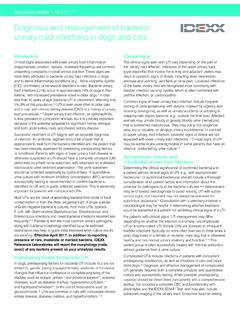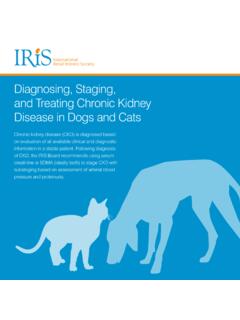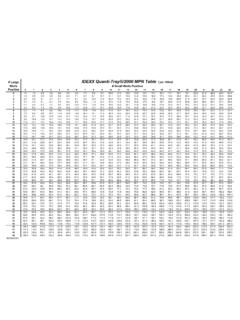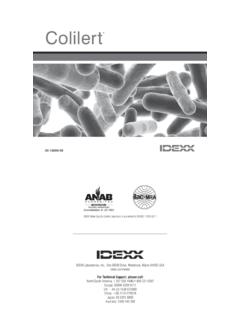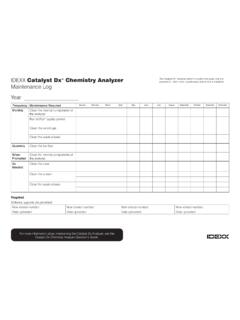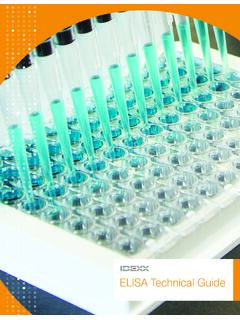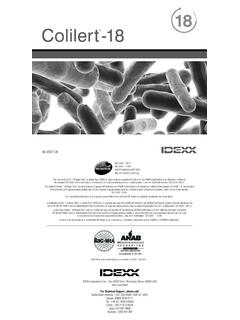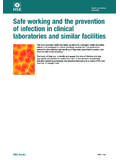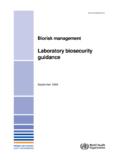Transcription of An update on the diagnosis and management of ... - IDEXX
1 Introduction Proteinuria is a general term that describes any type of protein, including albumin, globulins, Bence Jones proteins, and others, in the urine. When proteinuria is detected, its potential clinical significance must be established. First it needs to be determined where the protein is coming from and whether it is prerenal, renal, or postrenal. If it is renal in origin, then the magnitude of proteinuria needs to be quantified and determined to be persistent or not. With earlier recognition of chronic kidney disease (CKD) with the IDEXX SDMA Test, veterinarians are encouraged to evaluate for proteinuria earlier. Evidence suggests an association between renal proteinuria and progression of CKD in dogs and cats; the greater the magnitude of proteinuria, the greater the risk for progression of renal disease and possible 4 It has been shown that treatments can decrease proteinuria, slow the progression of CKD, and improve 7 Screening tests for detecting protein on a urinalysis There are several methods to measure protein on a routine urinalysis.
2 Colorimetric reagent strip (dipstick) methodThe most common method for providing a semiquantitative measurement of protein on a urinalysis is by the colorimetric reagent strip (or dipstick) method. These dipsticks can either be read visually or by an automated urinalysis analyzer at a reference laboratory or in-house ( IDEXX VetLab UA Analyzer). Historically, the colorimetric reagent method included on a urine dipstick was considered to have both a high rate of false negatives and of false positives. However in recent years, the colorimetric reagent method has improved significantly, and because of this, IDEXX Reference laboratories and other major university diagnostic laboratories have transitioned to this acid (SSA) precipitation testIn the past, the sulfosalicylic acid (SSA) method was used for confirmation of protein detected on urinalysis due to high specificity. However, the very low sensitivity (prone to false negatives) makes SSA unsuitable for use as a screening test for proteinuria.
3 As mentioned above, because of recent improvements in the colorimetric reagent method, SSA is no longer routinely performed at most veterinary diagnostic laboratories , including IDEXX Reference testThe microalbuminuria test is a very sensitive test for determining if albumin is present in the urine. This test is limited to the detection of albumin only and does not detect other urine proteins that may contribute to renal proteinuria. The microalbuminuria test is prone to false positives, and determining the clinical significance of a positive result requires follow-up testing with a urine protein:creatinine (UPC) origin of proteinuria Localization of proteinuria as prerenal, renal, or postrenal is the first step in determining its clinical proteinuriaPrerenal proteinuria can result from a number of processes that include systemic hypertension, overload of the glomeruli, and transient causes, such as shock, fever, and intense exercise. Hemoglobinuria (from hemolysis), myoglobinuria (from rhabdomyolysis) or immunoglobulins in the urine (from plasma cell cancers) may be seen with prerenal causes due to glomerular proteinuriaUrinary tract inflammation, urinary tract infection (UTI), urinary neoplasia, or urolithiasis can cause postrenal proteinuria.
4 If there is evidence of a UTI (white blood cells, red blood cells, and bacteriuria), a culture and minimum inhibitory concentration (MIC) susceptibility should be performed and the pet treated appropriately. After resolution of the UTI or other postrenal causes of proteinuria, a recheck urinalysis should be evaluated for proteinuria, and if still present, then a UPC should be performed. The question often arises about if the amount of red blood cells in the urine can affect the UPC ratio. Studies in dogs have shown that unless urine is visibly red, red blood cells in the urine should not significantly increase the UPC ratio. A recent study in cats, however, reported that the UPC ratio could be increased in feline urine specimens that were not visibly hematuric, and sediment examination findings must be taken into account when interpreting UPC ratio Renal proteinuriaProteinuria of renal origin results from two major mechanisms. Glomerular disease causes a loss of selective filtration that results in an increased amount of protein in the filtrate.
5 Glomerular disease is present in about 50% of dogs with CKD, but it is rare in cats. Tubular dysfunction can result in low-level proteinuria leading to a failure to process and reabsorb the small amount of protein, mainly albumin, that traverses the glomerular barrier. Evidence supports an association between renal proteinuria and progression of CKD in dogs and cats; the greater the magnitude of proteinuria, the greater the risk for progression of renal disease and possible 4 Importantly, treatments that attenuated proteinuria in dogs and cats with CKD also have been associated with slowed progression of CKD, improved survival, or 7An update on the diagnosis and management of proteinuria in dogs and catsDiagnostic updateInternational Renal Interest Society (IRIS) CKD guidelinesAfter diagnosis with CKD, the IRIS CKD staging guidelines should be applied to help guide Staging is based on a stable creatinine and SDMA. Substaging should be done for both blood pressure and proteinuria.
6 Substaging for proteinuria is done based on the UPC ratio (see table 1).13 The magnitude of the UPC ratio, once determined to be persistently increased, can be used to guide treatment, monitor progression, and evaluate therapeutic response. Quantifying renal proteinuria to guide management Once prerenal and postrenal causes of proteinuria have been ruled out, a UPC ratio can be performed to quantify the degree of renal proteinuria to determine its clinical significance. The UPC ratio is a quantitative measure of all urine proteins. This test can be performed at a reference laboratory or in-house on the IDEXX Catalyst One and Catalyst Dx chemistry analyzers. By measuring both the urine creatinine along with the urine protein, the UPC ratio normalizes for variations in urine concentration. See figure 1 for guidance on when to perform a UPC ratio based on the colorimetric reagent strip method Investigating for cause of proteinuria Investigating for and treating underlying systemic disease, such as infection, neoplasia, inflammatory disease, and immune-mediated disease, is recommended in both dogs and cats.
7 If a UPC ratio of > in a cat or > in a dog is persistent, then a workup is ,11 This includes a minimum diagnostic database with complete blood count (CBC), chemistry panel that includes SDMA testing, urine culture, and blood pressure should be performed. Blood pressure should be evaluated and hypertension should be treated if dogs, vector-borne disease testing with the SNAP 4Dx Plus Test, thoracic radiographs, abdominal ultrasound, and testing for hyperadrenocortism should be considered dependent on location, history, and physical examination. Evaluation for leptospirosis (antibody titers and PCR) should also be considered in dogs with acute proteinuria. In cats, thyroxin measurement (if over age 4) and FeLV and FIV screening should be part of the initial testing. Imaging and additional testing, such as feline pancreatic lipase level (Spec fPL Test or SNAP fPL Test) should be considered depending on history and physical renal proteinuria is persistent and an underlying cause cannot be found, a renal biopsy may be + or higherLikely significant proteinuria UPC indicatedProteinuria likely not significant UPC not indicatedColorimetric reagent strip/dipstick method resultFigure 1.
8 Guidelines for when to perform a UPC ratio in dogs and cats without prerenal or postrenal causes of proteinuria. Figure modified with permission from or 1+USG = in a dogUSG = in a catNoYesIncreased SDMA and/or increased creatinineTable 1. IRIS substaging by proteinuria in dogs and cats with protein: creatinine (UPC) ratioDogsCatsNonproteinuric (NP)< < proteinuric (BP) (P)> > dilute:USG concentrated:USG in a dogUSG in a catManaging proteinuria If treatment of concurrent disease does not result in reduction of proteinuria or if an underlying disease cannot be detected, then additional treatment is needed (for a UPC ratio of > in cats and > in dogs). The goal is to achieve a 90% reduction in proteinuria in cats and 50% reduction in moderately restricted in protein reduce the overall load of protein on the kidneys. By lowering circulating protein, there is less risk of protein overload across the filtration barrier and less tubular protein reabsorption.
9 Commercial renal diets for dogs and cats are moderately restricted in protein content and are therefore recommended in pets with protein-losing nephropathy (PLN).11 Angiotensin converting enzyme (ACE) inhibitorsACE inhibitors reduce proteinuria by reducing glomerular capillary pressure by dilating the efferent renal arteriole. Studies in dogs have shown a decreased risk in progressive azotemia and increased ,6 There is no benefit of using benazepril over enalapril in either dogs or cats other than that benazepril can often be dosed once receptor blocker (ARB)Telmisartan is an angiotensin I receptor blocker that spares the beneficial effects of the angiotensin II receptor. It has been shown to be as effective as benazepril in controlling proteinuria in cats with (eicosapentaenoic acid) supplementationDogs consuming omega-3 polyunsaturated fatty acids (n-3 PUFAs) have lower mortality, increased renal function, and reduced proteinuria and cholesterol. Prescription renal diets are often supplemented with n-3 therapyImmunosuppressants should be reserved for use when a diagnosis of immune-mediated glomerulonephritis has been made via a renal biopsy.
10 They should be considered only when proteinuria in a dog is severe, persistent, and/or progressive and there is no identified contraindication to immunosuppressive therapy. Mycophenolate alone or in combination with prednisolone should be considered when there is profound proteinuria, hypoalbuminemia, nephrotic syndrome, or rapidly progressive azotemia. For stable or slowly progressive glomerular diseases, mycophenolate or chlorambucil alone or in combination with azathioprine on alternating days should be acetylsalicylic acid (aspirin) should be considered as an adjunct therapy for protein-losing nephropathies, given that antithrombin III (ATIII) is often lost into the urine, making animals hypercoagulable. It is recommended to consider treatment in all cases with hypoalbuminemia. The dose of aspirin recommended is mg per kg of body weight daily in dogs and 5 mg every 72 hours in Monitoring proteinuria After initial treatment for proteinuria and after changes are made to therapy, follow-up should be in 1 4 weeks for physical examination, chemistry panel (including serum albumin, SDMA, and creatinine), UPC ratio, and blood pressure.
